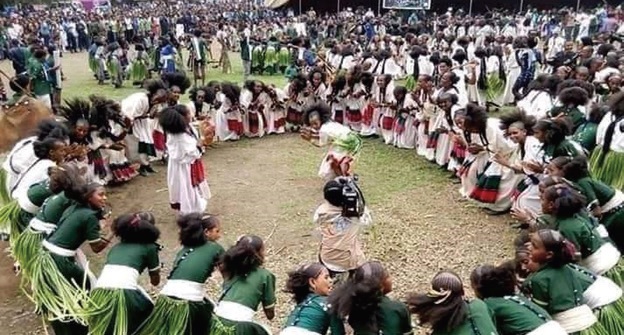
BY ELIZABETH MENGISTU
Every year, when the month August is approaching to end and the sunny season, Meskerem (September), is oncoming, the Ethiopians girls and young women in the northern part of the country, especially in Tigray and Amhara states, started reading themselves to celebrate the most awaited festival of Shadey-Ashendiye-Solel Festival.
Girls and young women, by creating groups, discuss how they can celebrate the festival; what to wear, how they would have the best possible appearance and be looking at their best. To this effect, they select the best attires, the style of their hair, as well as prepare all the necessary cosmetics and jewelries which could enhance their attractiveness.
As to an article written by Selam Balehey, and Mulubrhan Balehegn and titled, “The Art, Aesthetics and Gender Significance of Ashenda girls’ Festival in Tigray, Northern Ethiopia,” the cosmetics and ornamentations that the girls prepare include: ‘Kuhli’, an ancient eye cosmetic, or a black eye liner, ‘Elam’ or a local form of henna, Tesmi or milk cream applied on the hair and many herbs that provide pleasant and attractive aroma and smell that are applied on cloths.
Then after, the girls and young women adorned themselves with artistically made cultural dresses; braided their hair uniquely, beautifying themselves with various jewelries and strapping green grass around their waist, and holding drums (kebero) gather in a central place to sing, dance and enjoy the festival.
As studies indicate, the celebration is exclusive to Lasta Lalibela, North Sekota and Tigray and named in different names. It is known as “Ashenda” throughout Tigray, “Shadey” in Wag Hemra and by “Solel” in Raya Kobo.
Currently, the festival is celebrated in various areas; and in Sekota Town of Amhara State, Shadey-Ashendiye-Solel festival was colorfully celebrated in the presence of including Deputy Prime Minister and Foreign Minister Demeke Mekonnen and Amhara Region Chief Administrator, Yilkal Kefale (PhD), States’ and federal government officials, local and foreign tourists and residents of the State.
Speaking at the celebration in Lalibela, Demeke said that the cultural values of Ashendiye need to be promoted internationally as it has significant contribution to the development of tourism in the country.
The festival depicts cultural values that empowers, inspires and provides freedom to women and girls.
The festival is mostly celebrated in Amhara and Tigray regions in various ways including with traditional dancing and singing.
In this regard, the government is committed to develop the infrastructures around tourism destinations in the country and all stakeholders need to be supportive for the efforts.
Moreover, the cultural values of Ashendiye along with the historical rock-hewn churches of Lalibela are of crucial significance to attract more tourists and develop destination in connection with the festival and cultural heritages of Lalibela.
Amhara State President Yilkal Kefale on his part said that Ashendiye festival symbolizes the freedom for women and girls, noting that it is the cultural asset of all Ethiopian people.
Hence, all Ethiopians must exert efforts to promote this cultural event worldwide. “We need to exploit the tourism potentials and economic benefits of the culture,” he further said.
Yilkal further pointed out that the people and stakeholders need to be collaborative in the effort to promote the culture and develop tourism destinations, ENA reported.
Ethiopia has astonishing and impressive cultural values and heritages which make the country a favorable tourist destination for its visitors, said an Austrian tourist who got the opportunity to celebrate the festival at Lalibela Town.
As Ashewar Johan told to local media, she is visiting tourist attractions in Ethiopia along with her friends. During their week stay in the country, they visited the northern mountains and other attractions. She also expressed her delight for attending the Ashendiye Festival that took place in the historic town of Lalibela.
Watching girls and young women celebrate the festival adorned with stunning cultural dresses and accompanied by impressive songs, is too breathtaking. I realized that Ethiopia has a lot of amazing heritage and culture,” he said.
“In all areas we visited, the respect and welcoming approach we received from the communities is amazing. Even these days Ethiopia is a comfortable place for its visitors,” Ashewer Johan remarked.
When I get back home, I will recommend Ethiopia for my friends to come and visit the beautiful culture and wonderful heritages that I saw in Ethiopia,” she added.
Packle Hood, the other tourist who came from UK, also said that he has spent a wonderful and successful time in the areas he had visited.
He is also very happy for attending the Ashendiye Festival in addition to visiting the magnificent architecture of the historic Rock-Hewn Churches of Lalibela.
The festival, for those who may come to the country to visit the historic church of Lalibela on August, would create them a favorable environment to watch the breathtaking culture of Ethiopians, he said.
He also mentioned that he is spending a good time since he came to Ethiopia to visit country’s tourist attractions.
“Ethiopia has a wonderful culture and heritage,” said Rosemary Mia, a visitor from Israel.
Aside from visiting the historical monuments, watching girls and women celebrating their impressive culture accompanied by beautiful music is exciting.
“Ashendiye Festival is an impressive cultural event. All girls and young women are celebrating it in accordance with their age group, and this shows equality and unity,” she said.
Ashendiye festival is named after a long “Ashenda” grass which girls tie around their waist to hang down the skirt as a decoration. The Ashenda grass has come to symbolize the religious festival, as dancing girls move their waists causing the leaves to shake in an eye-catching manner.
Ashendiye festival is an outdoor festival celebrated every year from August 21 to 25 by girls and young women
The Ethiopian Herald 25 August 2022





